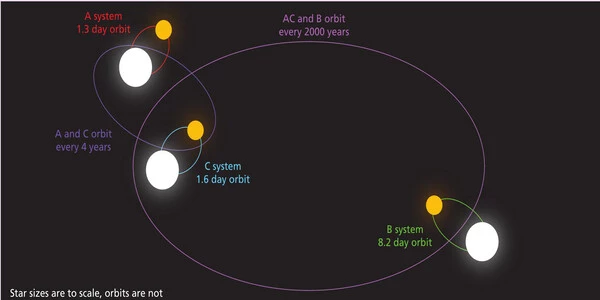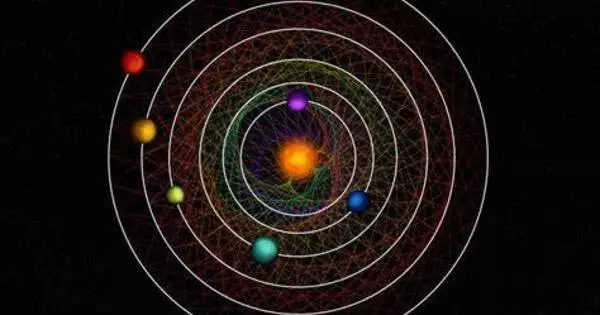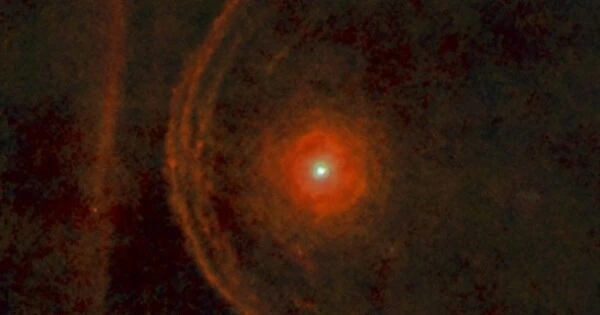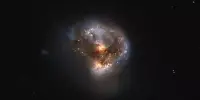A key new system of six transiting planets orbiting a bright star in a harmonic rhythm has been discovered by an international collaboration of astronomers using the CHEOPS and TESS space satellites, including NCCR PlanetS members from the University of Bern and the University of Geneva. This unusual property enabled the team to determine the planetary orbits, which had previously appeared to be an unsolvable puzzle.
CHEOPS is a joint ESA and Swiss mission led by the University of Bern in collaboration with the University of Geneva. The international team discovered the planetary system orbiting the nearby star HD110067 thanks to a collaboration with scientists using data from NASA’s satellite TESS.
The planets orbit their host star in perfect harmony, which is a distinguishing feature of this system. Researchers from the Universities of Bern and Geneva who are also members of the National Center of Competence in Research (NCCR) PlanetS are part of the research team. The findings were recently published in Nature.
The planets in the HD110067 system revolve around the star in a very precise waltz. When the closest planet to the star makes three full revolutions around it, the second one makes exactly two during the same time. This is called a 3:2 resonance.
“Among the over 5000 exoplanets discovered orbiting stars other than our Sun, resonances are common, as are multi-planet systems. What is extremely rare is to find systems with resonances that span such a long chain of six planets,” says Dr. Hugh Osborn, CHEOPS fellow at the University of Bern, leader of the CHEOPS observation program involved in the study, and co-author of the publication. This is the case with HD110067, whose planets form a “resonant chain” in successive pairs of 3:2, 3:2, 3:2, 4:3, and 4:3 resonances, resulting in the closest planet completing six orbits while the outer-most planet completes one.
Among the over 5000 exoplanets discovered orbiting stars other than our Sun, resonances are common, as are multi-planet systems. What is extremely rare is to find systems with resonances that span such a long chain of six planets.
Dr. Hugh Osborn
A seemingly unsolvable puzzle
Although multiple planets were discovered due to their transits, the exact arrangement of the planets was initially unknown. The precise gravitational dance, on the other hand, enabled the scientists’ team to solve the puzzle of HD110067. Prof. Adrien Leleu of the University of Geneva, who was in charge of analyzing the orbital resonances and is a co-author of the study, explains: “A transit occurs when a planet, from our point of view, passes in front of its host star, blocking a minute fraction of the starlight, creating an apparent dip in its brightness.”
From the first observations carried out by NASA’s TESS satellite, it was possible to determine that the two inner planets called ‘b’ and ‘c’ have orbital periods of 9 and 14 days respectively. However, no conclusions could be drawn for the other four detected planets as two were seen to transit once in 2020 and once in 2022 with a large 2-year gap in the data, and the other two transited only once in 2022.
The solution to the puzzle for those four additional planets finally began to emerge thanks to observations with the CHEOPS space telescope. While TESS aims at scanning all of the sky bit by bit to find short-period exoplanets, CHEOPS is a targeted mission, focusing on a single star at a time with exquisite precision. “Our CHEOPS observations enabled us to find that the period of the planet ‘d’ is 20.5 days. Also, it ruled out multiple possibilities for the remaining three outer planets, ‘e’, ‘f’, and ‘g’,” reveals Osborn.

Predicting the precise waltz of the planets
That’s when the team realized that HD110067’s three inner planets are dancing in a precise 3:2, 3:2 chain of resonances: the innermost planet revolves nine times around the star, the second six times, and the third four times.
The team then considered whether the three other planets could be part of the chain of resonances as well. “This led to dozens of possibilities for their orbital period,” says Leleu, “but combining existing observational data from TESS and CHEOPS, with our model of the gravitational interactions between the planets, we could exclude all solutions but one: the 3:2, 3:2, 3:2, 4:3, 4:3 chain.”
This prediction enabled the scheduling of observations with various ground-based telescopes. Additional transits of planet ‘f’ were observed, revealing that it was exactly where theory predicted it would be based on the resonant chain. Finally, reanalysis of TESS data revealed two hidden transits, one from each of planets ‘f’ and ‘g’, occurring exactly at the times predicted by the predictions, confirming the periods of the six planets. Additional CHEOPS observations of each planet, particularly planet ‘e’, are planned in the near future.
A key system for the future
Among the few resonant-chain systems discovered thus far, CHEOPS has made significant contributions to the understanding of not only HD110067 but also TOI-178. The TRAPPIST-1 system, which contains seven rocky planets, is another well-known example of a resonant-chain system. TRAPPIST-1, on the other hand, is a small and extremely faint star, making any additional observations extremely difficult. In comparison, HD110067 is more than 50 times brighter than TRAPPIST-1.
“The fact that the planets in the HD110067 system have been detected by the transit method is key. While they pass in front of the star, light also filters through the planetary atmospheres” points out Jo Ann Egger, PhD student at the University of Bern, who computed the composition of the planets using CHEOPS data, and co-author of the study.
Astronomers can use this property to determine the chemical composition and other properties of the atmosphere. Because a lot of light is needed, the bright star HD110067 and its orbiting planets are an ideal target for further research into the planetary atmospheres. “The HD110067 system’s sub-Neptune planets appear to have low masses, implying they are gas- or water-rich.” Future observations of these planetary atmospheres, such as those made with the James Webb Space Telescope (JWST), could reveal whether the planets have rocky or water-rich interior structures,” Egger concludes.
















